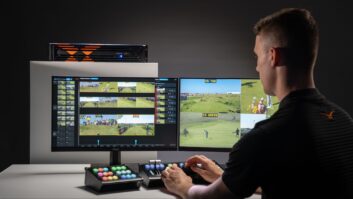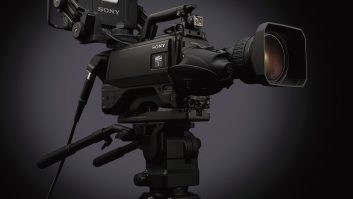Sony has added a new entry-level live production switcher to its suite of products.
The XVS-G1 is designed for live production needs, such as sports, news or entertainment programmes, and can be used in small to mid-size studios, outside broadcast vehicles, and fly-away production units.

The switcher’s hybrid structure pulls together a central processing unit (CPU), a graphics processing unit (GPU), and a field-programmable gate array (FPGA).
It includes FPGA hardware which enables real-time processing in high resolution 4K(UHD), wide colour gamut, as well as high-dynamic range (HDR) imaging with an ultra-low latency.
TAG Video Systems adds visualisation and monitoring support for Hawk-Eye
TAG Video Systems is to offer support for Sony’s Hawk-Eye camera on an IP, all software Multiviewer.
The company has integrated support for the camera into its IP-based MCM-9000, which provides full visualisation of content along with all other sources for display on the Multiviewer mosaic output. This enables users to monitor signal quality, health and integrity prior to feeding the Hawk-Eye vision processing system.
“Sony’s Hawk-Eye camera is immensely popular with sports broadcasters because of its optical tracking system and vision-processing technology that enable extremely accurate live ball and player tracking with full-field coverage,” said Paul Briscoe, TAG’s chief architect. “Previously, however, there was no way to directly view the camera’s output stream on an IP Multiviewer, but TAG is happy to announce that our MCM-9000 Multiviewer can now display them along with other sources on the same Mosaic output.”
pixitmedia enables rapid digitising of high-end content
Specialist film facility Cinelab London has employed pixitmedia’s pixstor solution as it’s digitised some major productions over the past 12 months.
Cinelab has worked on Wonder Woman 1984, No Time to Die, the Small Axe films and music videos for Beyoncé and Coldplay.

The company processes the content and then scans at 2K, 4K and 6K for next day viewing and editing. It has used pixstor as its day-to-day data storage system.
“The rate of scanning and writing data scales to massive levels when delivering for a big studio production,” said Adrian Bull, CEO of Cinelab London. “There is complexity in dealing with hundreds of thousands of individual files when scanning film, with folders of anything up to 40,000 .dpx files. A classic issue with directory listings of these files is speed – you need to be able to find a directory quickly, see what’s in it and manipulate it. pixitmedia’s central storage can store, organise and handle that write-heavy workflow.”







